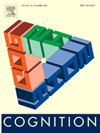节拍手势和韵律突出相互影响语言理解。
IF 2.8
1区 心理学
Q1 PSYCHOLOGY, EXPERIMENTAL
引用次数: 0
摘要
面对面的交流不仅是关于“说什么”,还有“怎么说”,包括语言和身体信号。打拍子手势是有节奏的手部动作,通常伴随着谈话中的韵律突出。然而,手势如何影响语言理解还不清楚。一方面,节拍手势可能与韵律突出具有相同的焦点标记功能。因此,他们会把注意力吸引到并发演讲上,并突出其内容。另一方面,打拍子手势可能会引发说话者高度自信的推断,产生对句子内容正确的期望,从而引出对语句真实性的承诺。本研究通过评估韵律突出和节拍手势对语言理解的叠加和交互作用,直接解开了这两种假设。参与者观看讲话者说话的视频,并判断每句话是对还是错。句子有时包含可能被忽视的世界知识冲突(“语义错觉”)。节拍手势与韵律突出相结合会导致更高程度的语义错觉,使更多的世界知识违反在语言理解过程中被忽视。这些结果挑战了当前的理论,即节拍手势是视觉焦点标记。相反,他们认为打拍子的手势会自动触发说话者高度自信的推断,从而引出对陈述真实性的承诺,这符合格赖斯的对话合作原则。更广泛地说,我们的研究结果也强调了元认知对面对面交流中语言理解的影响。本文章由计算机程序翻译,如有差异,请以英文原文为准。
Beat gestures and prosodic prominence interactively influence language comprehension
Face-to-face communication is not only about ‘what’ is said but also ‘how’ it is said, both in speech and bodily signals. Beat gestures are rhythmic hand movements that typically accompany prosodic prominence in conversation. Yet, it is still unclear how beat gestures influence language comprehension. On the one hand, beat gestures may share the same functional role of focus markers as prosodic prominence. Accordingly, they would drive attention towards the concurrent speech and highlight its content. On the other hand, beat gestures may trigger inferences of high speaker confidence, generate the expectation that the sentence content is correct and thereby elicit the commitment to the truth of the statement. This study directly disentangled the two hypotheses by evaluating additive and interactive effects of prosodic prominence and beat gestures on language comprehension. Participants watched videos of a speaker uttering sentences and judged whether each sentence was true or false. Sentences sometimes contained a world knowledge violation that may go unnoticed (‘semantic illusion’). Combining beat gestures with prosodic prominence led to a higher degree of semantic illusion, making more world knowledge violations go unnoticed during language comprehension. These results challenge current theories proposing that beat gestures are visual focus markers. To the contrary, they suggest that beat gestures automatically trigger inferences of high speaker confidence and thereby elicit the commitment to the truth of the statement, in line with Grice’s cooperative principle in conversation. More broadly, our findings also highlight the influence of metacognition on language comprehension in face-to-face communication.
求助全文
通过发布文献求助,成功后即可免费获取论文全文。
去求助
来源期刊

Cognition
PSYCHOLOGY, EXPERIMENTAL-
CiteScore
6.40
自引率
5.90%
发文量
283
期刊介绍:
Cognition is an international journal that publishes theoretical and experimental papers on the study of the mind. It covers a wide variety of subjects concerning all the different aspects of cognition, ranging from biological and experimental studies to formal analysis. Contributions from the fields of psychology, neuroscience, linguistics, computer science, mathematics, ethology and philosophy are welcome in this journal provided that they have some bearing on the functioning of the mind. In addition, the journal serves as a forum for discussion of social and political aspects of cognitive science.
 求助内容:
求助内容: 应助结果提醒方式:
应助结果提醒方式:


